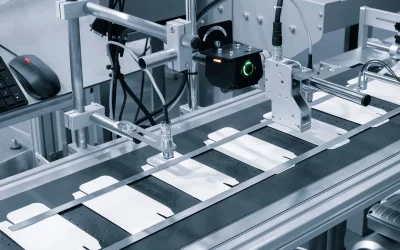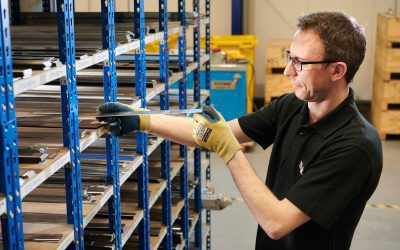What is a slitter blade?
As the name suggests, a slitter blade is a blade which is designed for the purpose of slitting things.
But what exactly is meant by the word slit?
Pick up a dictionary and you’ll find the word ‘slitting’ defined as the act of ‘making a long, narrow cut’ in a material.
And, that’s exactly what slitter blades do.
They are used to cut or convert materials down into narrower strips and are usually circular in shape. As they are circular, slitting blades have a ‘continuous’ blade edge.
This makes slitter blades ideal for applications and scenarios where a continuous incision needs to be made. That’s one of the reasons slitter blades lend themselves so readily to high-volume processes.
Because of their circular nature, slitter blades are also perfect for creating uniform cuts on a high-volume basis. Slitter blades can make continuous and repeated incisions that are completely uniform in nature.
It’s also worth noting that slitter blades work in a slightly different way from many traditional blades. Whereas traditional blades work in a linear motion, moving back and forth on a single plane, slitter blades work in a cyclical motion, thereby reducing wear and tear on the mechanisms that drive them.
Slitter blades are also available with different types of blade edges. For example, it’s possible to purchase slitter blades which have a toothed edge that can create perforated cuts e.g. tear-off lines on packaging.
What are slitter blades used for?
Slitter blades are used in a wide variety of different industries, across many different applications. Below we’ve set out some of the most common ways in which slitter blades are used.
Paper
Because of their properties and the way in which they can make delicate, yet highly precise cuts, slitter blades have found extensive use in the converting of paper.
In addition to slitter blades with a continuous edge – used to create slits in paper – slitter blades with toothed edges are used in the paper industry to create tear-lines and other perforated cuts.
Meats
Slitter blades have found extensive use in the meat processing industry. They are not only ideal for slitting meats into narrow strips, but are also used to score meats such as beef, poultry and fish.
In many instances, custom slitter blades are used to accommodate very specific cuts and/or machinery types in the meat processing industry.
Foil and film
Materials such as foils and films require very sharp blades in order to achieve consistent, correct cuts.
That’s why slitter blades are used to cut foils and films. Their razor sharp edge makes them ideal for cutting these types of materials.
Corrugated products
Because of the characteristics of corrugated products such as cardboard and fibreboard, these materials require high-quality blades in order to achieve correct and consistent cuts.
As such, slitter blades are the blade of choice in scenarios requiring the cutting of corrugated products.
Textiles
Textiles and fabrics can subject blades to a punishing amount of wear and tear. That’s why slitter blades are commonly used in the cutting of textiles and fabrics. This is because slitter blades are able to retain their edge throughout regular cutting operations.
Plastics and synthetic materials
Slitter blades are also used in processes that require the cutting of plastics and other similar synthetic materials.
Like many of the other applications listed here, slitter blades are favoured for the cutting of plastics and similar synthetic materials because they are able to make precise, uniform cuts whilst retaining their edge over prolonged operating cycles.
What are the different types of slitting?
As you may have picked up, there are in fact different types of slitting that a slitter blade can be used for.
Below we’ve detailed some of the most common types of slitting that are used in the food processing, packaging and other industries.
Crush cut slitting
Crush cut slitting is the process of using brute force to penetrate the slitter blade through a material.
This brute force is generally applied to the slitter blade via a pneumatic knife-blade holder. The slitter blade will be pressed into the material which will be resting on a hardened anvil roll or other similarly tough surface.
Crush cut slitting is usually used on very tough materials such as rubbers and sand papers. However, it’s not unusual for more lightweight materials such as tissues and laminates to be subjected to crush cut slitting too.
Razor slitting
Razor slitting involves the use of slitter blades mounted at an angle in either individual holders or a larger cassette to cut materials.
In this type of cut, the slitter blades will remain stationary as the material to be cut is run over them.
Razor slitting is ideal for the cutting of materials such as films, vinyls, plastics, tapes and ribbons.
Shear slitting
Shear slitting is a slightly more complex cutting process, yet uses slitter blades to achieve highly precise cuts.
The process of shear slitting involves the use of both male and female slitter blades to create a rotating ‘scissor’ effect.
The female slitter blades are generally shaft mounted whilst the male slitter blades are either individually mounted or shaft mounted.
Shear slitting, whilst more complicated to set up and maintain than other slitting types, provides exceptional cut quality and very high speeds, and can be used on a wide variety of materials such as films, paper, laminates, tapes, textiles, foils and many more.
What qualities should a slitter blade have?
When you’re selecting slitter blades for your machines and processing lines, there are a number of qualities that you want to look out for.
The qualities a slitter blade should have, include:
- Being manufactured out of high-quality stainless steel.
- Being manufactured from food-safe stainless steel if used for food processing purposes.
- A razor sharp edge.
- Compatibility with a wide range of machinery.
- Availability in multiple finishes such as hard chrome, high-polish or Teflon, to increase lifespan.
- High hardness and minimal flexibility.
All of the slitter blades at MRMK possess these qualities. At MRMK we have extensive experience creating the very-finest slitter blades, with our unique approach to blade creation making them stand out from other slitter blades on the market.
MRMK’s approach to creating slitter blades
Here at MRMK we take a unique approach to the manufacture of slitter blades (and other blades for that matter).
Our approach is as follows:
Quality first
MRMK has a vision to create blades that possess a consistent balance of quality and value for money.
Creating a new standard
At MRMK we believe that you shouldn’t have to compromise when it comes to slitter blades. So, we don’t!
Our slitter blades are designed to be effective, durable and to provide high-performance cutting, reducing downtime.
Customer satisfaction guaranteed
We put customer satisfaction first. And, we are able to do so because we own one of the world’s best machine knife factories, and can break the decades-long cycle in the machine blade industry of overcharging and under delivering.
At MRMK, we do things the right way, keeping you, the customer happy.
Find out more about MRMK’s slitter blades and other circular knives
For more machine blade advice, information and news, explore the MRMK news and insights hub…
MRMK at Anuga FoodTec 2022 | Choosing the Right Cutting Tools for Your Food Processing Operations | How to Renew Your Industrial Machine Knives


 +44 (0) 1909 519815
+44 (0) 1909 519815 


